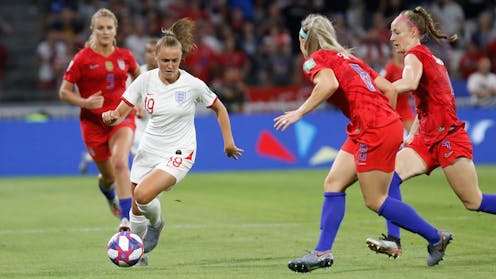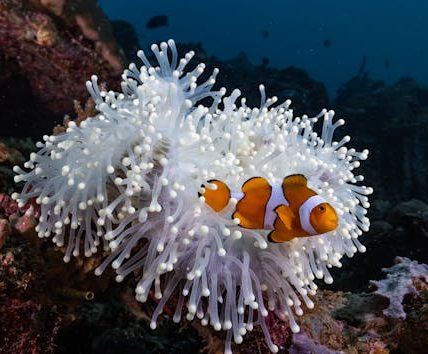Women’s Euro 2025: what players do to recover between matches — and how they prepare for their next game
Recovery starts for England’s Lionesses as soon as the match ends. Romain Biard/ Shutterstock
As with many competitions, competitors in the UEFA Women’s Euro 2025 tournament face a gruelling match schedule. There are typically only three or four days between matches during the group stage of international tournaments – with some teams even facing tighter turnarounds depending on scheduling.
This congested fixture schedule places a significant physical demand on players, increases injury risk and makes it challenging to sustain peak physical performance. This is why recovery strategies are put into action from the moment the match ends so players are in peak condition for the next match.
The first recovery strategy happens as soon as players arrive in the changing room. There will be a buffet-style food selection with plenty of carbohydrate and protein-based snacks to begin refuelling. Players also typically consume a “recovery” drink. This consists of carbohydrates to restore muscle glycogen (which our body uses for energy), and around 20-30 grams of protein to aid muscle repair.
Get your news from actual experts, straight to your inbox. Sign up to our daily newsletter to receive all The Conversation UK’s latest coverage of news and research, from politics and business to the arts and sciences.
Over the following days, players will follow a meticulously-planned diet with the correct balance of carbohydrates, protein, fats and nutrients (such as the polyphenols found in tart cherry juice) to support muscle repair and adaptation.
Sweat loss during matches – particularly in summer tournaments – leads to significant dehydration. Players typically sweat around 1.5 litres or more during a match. Immediately after a match, players are given isotonic drinks to replace the water and electrolytes (specifically sodium) they’ve lost through sweating.
To estimate fluid loss, players’ post-match weight is recorded to guide how much they should drink. A one kilogram reduction in body weight corresponds to roughly one litre of fluid lost through sweating. To re-hydrate, players drink around 1.5 litres per kilogram of weight lost.
Physical recovery
Some players might perform around 10-15 minutes of low-intensity aerobic activity immediately following the match – such as cycling. This light activity maintains blood flow to the muscles, which might reduce the feeling of muscle soreness in the following days, although the evidence for this is inconclusive.
Players often use cold water immersion (ice baths) to reduce inflammation, swelling and muscle soreness. This involves standing or sitting in cold water (which is between 10–15°C) for around 10–15 minutes. Players may also take ice baths in the days between matches. Although there’s debate over whether ice baths speed up recovery, it remains a widely accepted practice in elite sport where rapid recovery is prioritised.
Another option involves alternating between hot water (around 36°C) and cold water – a practice known as contrast water therapy. Contrast water therapy causes the blood vessels to constrict in the cold water, then dilate in the hot water. This practice may enhance blood flow, reduce swelling and decrease muscle soreness.
Players often wear compression garments for several hours post-match and overnight. These garments enhance blood flow and reduce swelling. They’re also shown to reduce pain and muscle soreness.
Recently, inflatable compression leg sleeves have become popular among athletes. These boots inflate and deflate cyclically to promote blood flow and lymphatic drainage. This works similar to a sports massage or contrast water therapy, helping clear inflammatory proteins from the body. This may reduce swelling and decrease the severity of muscle soreness.
Sleep also plays a crucial role in a player’s physical and mental restoration between tournament matches. Players are encouraged to get eight to ten hours of quality sleep per night. Some players even take a 20-90 minute nap in the early afternoon to increase alertness, improve mood and potentially improve performance.
Recovery will be tailored to each player.
Jose Breton- Pics Action/ Shutterstock
Good sleep hygiene can help players get a good night’s sleep even despite hectic tournament schedules. This involves ensuring their bedroom is cool and dark and minimising screen time before bed.
Preparing for the next match
The day after a match, players will perform a recovery session incorporating some sort of light activity – such as cycling, dynamic movements in the swimming pool and foam rolling (a type of self-massage that uses a foam cylinder to apply pressure to different muscles).
Although light activity does not accelerate muscle recovery, it can offer psychological benefits – such as reducing the feeling of muscle soreness and stiffness. Players may also undergo targeted physiotherapy and massage to reduce muscle soreness, increase mobility and ease pain.
Recovery time varies between players and the level of fatigue they experience. Fatigue will be influenced by the player’s age and their match demands – with players who run a greater distance or perform more sprints and changes of direction typically taking more time to recover between matches.
Players’ fatigue is monitored between matches using various methods – including GPS data, biochemical markers of inflammation and muscle damage, and wellness questionnaires. This data is used to individualise training and recovery.
Players showing elevated fatigue might perform light technical drills, tactical walkthroughs of different plays and strategies the player might use on the field and mobility-focused gym work to maintain sharpness without causing more fatigue. Whereas players whose fatigue levels have returned to close to normal will resume normal training.
Performing on the world stage with the weight of national pride brings intense pressure. Players must contend with media scrutiny coupled with the expectations of coaches and fans. These factors can disrupt sleep and trigger a biological stress response, which may impair recovery.
So to help manage mental stress, teams schedule structured downtime, encouraging players to connect with family or engage in hobbies that promote mental recovery and psychological detachment from football. Sports psychologists may also support players during tournaments, providing mental skills training and helping players develop strategies to cope with stress and pressure.
Paul Hough does not work for, consult, own shares in or receive funding from any company or organisation that would benefit from this article, and has disclosed no relevant affiliations beyond their academic appointment.



